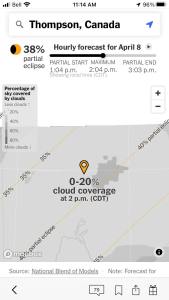I
 s today’s partial 38 per cent solar eclipse over Thompson, Manitoba, under clear blue skies and balmy 16°C temperatures (the normal April 8 daytime high is 4°C), a sign of a premillennial Rapture signalling the beginning of the End of Days, as today’s total eclipse crosses two towns in the United States named Nineveh in Ohio and Indiana, as well as Rapture, Indiana? The original Nineveh, the oldest and most-populous city of the ancient Assyrian empire, is situated on the east bank of the Tigris River and encircled by the modern city of Mosul, Iraq. Interestingly, today’s solar eclipse is not visible in Mosul.
s today’s partial 38 per cent solar eclipse over Thompson, Manitoba, under clear blue skies and balmy 16°C temperatures (the normal April 8 daytime high is 4°C), a sign of a premillennial Rapture signalling the beginning of the End of Days, as today’s total eclipse crosses two towns in the United States named Nineveh in Ohio and Indiana, as well as Rapture, Indiana? The original Nineveh, the oldest and most-populous city of the ancient Assyrian empire, is situated on the east bank of the Tigris River and encircled by the modern city of Mosul, Iraq. Interestingly, today’s solar eclipse is not visible in Mosul.
Not being either a scholar of eschatology or astronomy, I probably wouldn’t even be contemplating such a question about the April 8 solar eclipse if it hadn’t been for my old Left Coast friend Ron Graham posting on Facebook today, “To those religious nutcases that believed the upcoming solar eclipse would be ‘the rapture’, be sure to check in with us on Tuesday. It quite possibly did happen for some, but appears that Jesus overlooked you and your friends for some reason.”
While it is true that Christian scripture records that Jesus preaching on the Mount of Olives, a mountain ridge in East Jerusalem, east of and adjacent to Jerusalem’s Old City – in what is called the Olivet Discourse, found in Matthew 24 – talks about the end times and says the sun will be darkened, belief in apocalyptic happenings portended by solar eclipses are not proprietary to Christianity. Throughout history, eclipses have been interpreted by many cultures and religions as a disruption of the natural order.
Hindu beliefs involve demons swallowing the sun. In ancient China, the etchings discovered in Anyang depicted solar eclipses as celestial dragons attacking and devouring the sun. In South America, ancient Incans believed solar eclipses were a “sign of wrath and displeasure” from Inti, the “all-powerful sun god.” Choctaw Indians from the Southeastern Woodlands of the United States believe a mischievous black squirrel gnawing on the sun causes solar eclipses, and legend holds the squirrel must be frightened away by the clamor and yells of the event’s human witnesses. In West Africa, the Tammari people, also known as Batammariba from the northern regions of Togo and Benin, believe the celestial bodies intersecting during an eclipse represent human feuds on Earth.
Well I hear you went up to Saratoga
And your horse naturally won
Then you flew your Lear jet up to Nova Scotia
To see the total eclipse of the sun
I have always loved Carly Simon’s 1972 song “You’re So Vain.” In the early 1980s, many of us thought the song was about singer James Taylor, who was married to Carly Simon from 1972 to 1983. But in a 1983 interview with the Washington Post, Simon said, “”It certainly sounds like it was about Warren Beatty, He certainly thought it was about him – he called me and said ‘thanks for the song. ‘” Later, she said two other men, who so far remain unidentified, along with Beatty, also inspired elements of the song. So who knows?
As I said, I am neither a scholar of eschatology or astronomy, so perhaps it is not surprising my interest in solar eclipses is anchored elsewhere.
In the 1980s, I spent a too short part of many a summer at the Dell family’s summer home on the Atlantic Ocean in Oak Bluffs on Martha’s Vineyard in Massachusetts, where my mother-in-law, Carol Dell, a Vineyarder by both birth and disposition, would tell me stories of Carly Simon and James Taylor, who were also both in many ways Vineyarders themselves. Stories about Island events such as live performances at the Hot Tin Roof, opened in 1979 by Carly Simon, George Brush and Herb Putnam. Close your eyes, and you were transported back a few years in time and were there, so it seemed. Magical. The full lyrics to “You’re So Vain” go like this:
Son of a gun
You walked into the party like you were walking onto a yacht
Your hat strategically dipped below one eye
Your scarf it was apricot
You had one eye in the mirror, as you watched yourself gavotte
And all the girls dreamed that they’d be your partner
They’d be your partner and
You’re so vain
You probably think this song is about you
You’re so vain (you’re so vain)
I bet you think this song is about you
Don’t you, don’t you?
You had me several years ago when I was still quite naive
Well you said that we made such a pretty pair and that you would never leave
But you gave away the things you loved
And one of them was me
I had some dreams they were clouds in my coffee, clouds in my coffee and
You’re so vain
You probably think this song is about you
You’re so vain, you’re so vain
I bet you think this song is about you
Don’t you don’t you, don’t you?
I had some dreams they were clouds in my coffee, clouds in my coffee and
You’re so vain
You probably think this song is about you
You’re so vain (you’re so vain)
I bet you think this song is about you
Don’t you don’t you
Well I hear you went up to Saratoga
And your horse naturally won
Then you flew your Lear jet up to Nova Scotia
To see the total eclipse of the sun
Well you’re where you should be all the time
And when you’re not, you’re with some underworld spy
Or the wife of a close friend, wife of a close friend and
You’re so vain
You probably think this song is about you
You’re so vain (so vain)
I bet you think this song is about you
Don’t you don’t you, don’t you, don’t you now
You’re so vain
You probably think this song is about you
You’re so vain
Probably think this song about you
You’re so vain
https://www.youtube.com/watch?v=oGQ2DJ65-ok&t=6s
You can also follow me on X (formerly Twitter) at: https://twitter.com/jwbarker22






